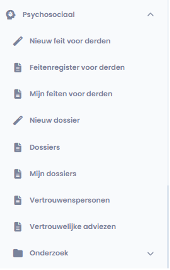Workplace mental health: a look at Psychosocial Risk Management
The emphasis on employee mental health and well-being has expanded dramatically in recent years. Work-related stress is a prevalent and costly issue in today's workplace. And we shouldn't leave this unnoticed.

| IN THIS ARTICLE |
|
1. Workplace stress is a widespread issue 2. How can VARIO assist in paying more attention to this problem? |
Psychosocial Risk Managment: workplace stress is a widespread issue
The media is increasingly reporting on the rise in burnouts.
According to recent Riziv data, the number of Belgians suffering from burnout has increased by around 10% per year over the last four years, and about 30% of Belgian workers are at danger of burnout.
The Welfare Act (Codex I.3) emphasises on risk management (detect, evaluate, and prevent) and prevention methods that are suited to the organisation (at the organisational, functional, or individual levels).
Controlling complaints, dangers, disease, and reintegration is critical, but it is not adequate. It is equally critical to prioritise healthy staff. That includes not only looking for answers to the most pressing issues (such as stress management and burnout reduction), but also focusing on building competencies and strengths.
This can be accomplished by adopting a policy on mental health and resilience. According to research, just 4 out of 10 firms structurely prioritise mental well-being at work.
How can VARIO assist in your Psychosocial Risk Management?
The risk management module of the VARIO software allows the examination of psychosocial risks to be incorporated and quantified.
Psychosocial risks can be investigated in a variety of methods, including the following:
- The psychosocial risks questionnaire is a tool for detecting and assessing psychosocial risks at work. The questionnaire supplements the first two processes of risk assessment (risk identification and analysis) and serves as the starting point for the third step (action). It exhaustively probes for impediments and resources in terms of work structure, work content, working conditions, working conditions, and labour relations using the Job Demands - Resources model (Demerouti, Bakker, Nachreiner, & Schaufeli, 2001).
- The "Flashing Lights Psychosocial Risks" tool can be used to acquire an early indication of the presence of psychosocial hazards in the enterprise as well as the level at which they occur (green light: few problems, orange light: warning signal, red light: alarm).
- The SOBANE occupational risk management plan was created to put in place a dynamic and efficient risk management policy. The principle is to deploy the resources and competencies required based on the complexity of the problems. The technique consists of four intervention levels: screening (detection); observation; analysis; and expertise.
Furthermore, our 'Psychosocial' module allows you to register psychosocial files. The files cover not only stress and burnout, but also hostility, prejudice, bullying, and alcohol and drug usage). This module allows you to conduct the necessary investigations, keep all records related to the file, and provide the appropriate confidential advice. Reports on all of these topics are simple to create.

Not to mention that security rights can be configured so that everything is kept private. These security privileges can also be configured on our entire document management, where policy documents, for example, can be saved.
With VARIO, you have a solution that allows you to identify psychosocial risks. If you improve policies around mental wellbeing, you also are taking a step towards improving mental wellbeing in the workplace. Get in touch, if you'd like to learn more.
%20(1).webp?width=2000&name=two-happy-businessman-working-laptop%20(3)%20(1).webp)


